
"I Heard It Through the Grapevine" is a song written by Norman Whitfield and Barrett Strong for Motown Records in 1966. The first recording of the song to be released was produced by Whitfield for Gladys Knight & the Pips and released as a single in September 1967. It went to number one on the Billboard R&B Singles chart and number two on the Billboard Pop Singles chart and shortly became the biggest selling Motown single up to that time.
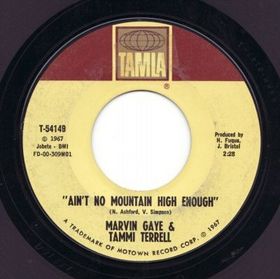
"Ain't No Mountain High Enough" is a song written by Nickolas Ashford & Valerie Simpson in 1966 for the Tamla label, a division of Motown. The composition was first successful as a 1967 hit single recorded by Marvin Gaye and Tammi Terrell, and became a hit again in 1970 when recorded by former Supremes frontwoman Diana Ross. The song became Ross's first solo number-one hit on the Billboard Hot 100 chart and was nominated for the Grammy Award for Best Female Pop Vocal Performance.
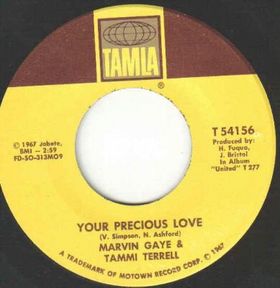
"Your Precious Love" is a popular song that was a 1967 hit for Motown singers Marvin Gaye and Tammi Terrell. The song was written by Nickolas Ashford and Valerie Simpson, and produced by Harvey Fuqua and Johnny Bristol. The doo-wop styled recording features background vocals by Fuqua, Gaye, Terrell and Bristol, and instrumentals by The Funk Brothers with the Detroit Symphony Orchestra. The song peaked at #5 on Billboard Pop Singles chart, #2 on Billboard's R&B Singles chart, and the top 40 on Billboard's Easy Listening survey. The song was later sampled by Gerald Levert on the song, "Your Smile", on his 2002 album, The G Spot.

"You're All I Need to Get By" is a song recorded by the American R&B/soul duo Marvin Gaye and Tammi Terrell and released on Motown Records' Tamla label in 1968. It was the basis for the 1995 single "I'll Be There for You/You're All I Need to Get By" from Method Man and Mary J. Blige.

"Ain't Nothing Like the Real Thing" is a 1968 single released by American R&B/soul duo Marvin Gaye and Tammi Terrell, on the Tamla label in 1968. The B-side of the single is "Little Ole Boy, Little Ole Girl" from the duo's United LP. The first release off the duo's second album: You're All I Need, the song - written and produced by regular Gaye/Terrell collaborators Ashford & Simpson - became a hit within weeks of release eventually peaking at number 8 on the Billboard Hot 100 and number 1 on the Hot Soul Singles chart, the first of the duo's two number 1 R&B hits. In the UK "Ain't Nothing Like the Real Thing" reached number 34.

"Ain't That Peculiar" is a 1965 song recorded by American soul musician Marvin Gaye for the Tamla (Motown) label.
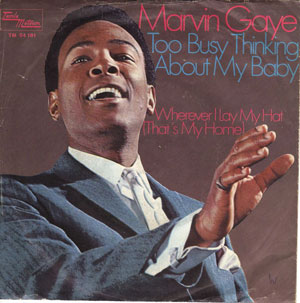
"Too Busy Thinking About My Baby" is a Motown song written by Norman Whitfield, Barrett Strong, and Janie Bradford. The song was first recorded by The Temptations as a track on their 1966 album Gettin' Ready. Eddie Kendricks sings lead on the recording, which was produced by Whitfield. Jimmy Ruffin also recorded a version with The Temptations providing background vocals in 1966. It remained unreleased until 1997.

"Abraham, Martin and John" is a 1968 song written by Dick Holler. It was first recorded by Dion, in a version that was a substantial North American chart hit in 1968–1969. Near-simultaneous cover versions by Smokey Robinson and the Miracles and Moms Mabley also charted in the U.S. in 1969, and a version that same year by Marvin Gaye became the hit version in the UK. It was also a hit as part of a medley for Tom Clay in 1971, and has subsequently been recorded by many other artists.

In the Groove is the eighth studio album by soul musician Marvin Gaye, released on August 26, 1968 on the Motown-subsidiary label Tamla Records. It was the first solo studio album Gaye released in two years, in which during that interim, the singer had emerged as a successful duet partner with female R&B singers such as Kim Weston and Tammi Terrell. In the Groove was reissued and retitled as I Heard It Through the Grapevine after the unexpected success of Gaye's recording of the same name, which had been released as a single from the original album.
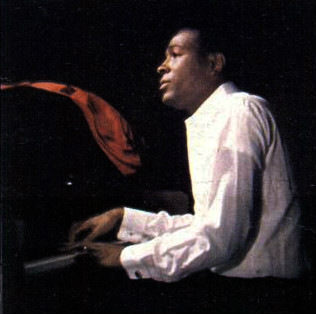
American music artist Marvin Gaye released 25 studio albums, four live albums, one soundtrack album, 24 compilation albums, and 83 singles. In 1961 Gaye signed a recording contract with Tamla Records, owned by Motown. The first release under the label was The Soulful Moods of Marvin Gaye. Gaye's first album to chart was a duet album with Mary Wells titled Together, peaking at number forty-two on the Billboard pop album chart. His 1965 album, Moods of Marvin Gaye, became his first album to reach the top ten of the R&B album charts and spawned four hit singles. Gaye recorded more than thirty hit singles for Motown throughout the 1960s, becoming established as "the Prince of Motown". Gaye topped the charts in 1968 with his rendition of "I Heard It Through the Grapevine", while his 1969 album, M.P.G., became his first number one R&B album. Gaye's landmark album, 1971's What's Going On became the first album by a solo artist to launch three top ten singles, including the title track. His 1973 single, "Let's Get It On", topped the charts while its subsequent album reached number two on the charts becoming his most successful Motown album to date. In 1982, after 21 years with Motown, Gaye signed with Columbia Records and issued Midnight Love, which included his most successful single to date, "Sexual Healing". Following his death in 1984, three albums were released posthumously while some of Gaye's landmark works were re-issued.
"The Onion Song" was a hit for soul singers Marvin Gaye and Tammi Terrell in 1969. It reached the top ten overseas, where it became Gaye & Terrell's biggest hit in the United Kingdom, entering the singles chart on 15 November 1969 and peaking at No.9 on 9 December. "The Onion Song" was a more modest hit in the U.S. where it peaked at No. 18 on the soul singles chart and No. 50 on the Billboard Hot 100
"You" is a 1967 single released by American singer Marvin Gaye on the Tamla label.
"The End of Our Road" is a single written by Roger Penzabene, Norman Whitfield and Barrett Strong in 1967. Originally recorded by Gladys Knight & the Pips and issued as a single in 1968, the Pips' version of the song, became another top forty hit for the family group as it peaked at number fifteen on the pop singles chart and number five on the R&B singles chart.
"Keep On Lovin' Me Honey" is a 1968 hit written and produced by Nickolas Ashford & Valerie Simpson, and issued as a single on Motown Records' Tamla label by Marvin Gaye and Tammi Terrell. It was the third release from the duo's You're All I Need album. Billboard described the single as a "potent, driving rocker" that "will put [Gaye and Terrell] rapidly at the top." Cash Box said that it "blazes its way with terrific rhythmic impact and super-powered vocal splendor."
"California Soul" is a funk-soul tune written by Ashford & Simpson, issued originally as the B-side of the Messengers' single "Window Shopping" in 1967 under the Motown group of labels.
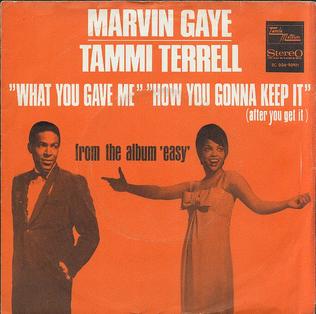
"What You Gave Me" is a hit duet written and produced by Ashford & Simpson and issued as a single originally by the vocal duo of Marvin Gaye and Tammi Terrell in 1969 on the Tamla label.

"How Sweet It Is (To Be Loved by You)" is a song recorded by American soul singer Marvin Gaye from his fifth studio album of the same name (1965). It was written in 1964 by the Motown songwriting team of Holland–Dozier–Holland, and produced by Brian Holland and Lamont Dozier. The song title was inspired by one of the actor and comedian Jackie Gleason's signature phrases, "How Sweet It Is!"
















